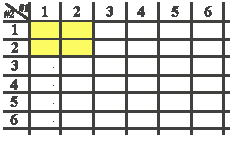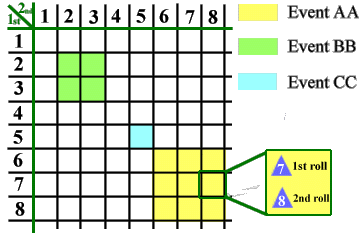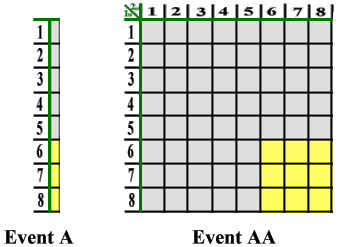Probability of Simultaneous Events
|
Mentor: Let us look at a game using two players and one six-sided die. The first player moves when the die rolls a 1 or 2, and the second one moves when the die rolls a 3, 4, 5, or 6. The player who reaches the finish first wins. The finish is just two steps from the start. What is the probability of each player winning? This problem is somewhat like a Russian doll,a set of dolls of decreasing sizes placed one inside another: it has problems within problems. After you solve it, you will see why. The best way to start is to find the experimental probability, that is, to play the game many times to see how often each player wins. You might want to combine the results of several people to save time on experiments, or use a computer. How often do you expect each player to win, in theory? Student 1: The first one will win in about 1/3 of all the games, and the second one in about 2/3 of all the games. Student 2: Wait, what about the two steps? And the results we saw when we tried the game did not show us that. Mentor: As you can see from the experiments, the second player wins more often than two thirds of the games, and the first player wins less often than one third of the games. Why do you think this is? Let us make a little investigation into the circumstances when the first player wins. For example, the first player can win by making two moves in a row. Are there other ways the first player can win? Let us look at the event when the first player makes two moves in a row and wins. What is the probability of that event? To answer that question, let us think of the die. For the event to happen, it has to roll a 1 or 2 the first time, and then a 1 or 2 again the second time. Each time the probability of rolling a 1 or 2 is 1/3. We can count the outcomes using a table. The event: "The first player makes two steps in a row" means that the roll is a 1 or 2 the first time (the probability of that is 1/3), and 1 or 2 the second time (the probability of that is also 1/3). What is the probability of the event? As usual, we use the formula: PROBABILITY OF WINNING =
To count the outcomes, we can use a table with all possible numbers for the die on the first roll and on the second roll:

As you can see, the event: "The first player makes two steps in a row" contains 4 outcomes out of 36, so the probability of that event is 4/36 = 1/9. Note that the probability of the first player making each step is 1/3, and 1/9 = 1/3 * 1/3. Is it a coincidence? Why? Mentor: Let us look at several more examples to investigate this "coincidence." To separate the examples from our main discussion, we will use an eight-sided die for them.
Suppose we roll an eight-sided die. There are several events we will discuss: Event A={6, 7, or 8 shows when we roll the die} Event B={2 or 3 shows when we roll the die} Event C={5 shows when we roll the die} Event AA={we roll the die twice, and get 6, 7, or 8 both times} Event BB={we roll the die twice, and get 2 or 3 both times} Event CC={we roll the die twice, and get 5 both times} Mentor: What is the probability of each of these events? Student 1: Event A happens in three out of eight chances, so P(A)=3/8=.375 or 37.5%. Student 2: P(B)=2/8=1/4=.25 or 25% Student 3: P(C)=1/8=.125 or 12.5% Student 1: What about the double-letter events? We will use a table:

Student: Let us see. P(A)=3/8, and P(AA)=9/64=3/8*3/8. It happens again! Why? Mentor: There are 3 outcomes in Event A out of the total of 8. When we roll the die twice (or roll two dice, which is the same), what is the total number of outcomes? Student 1: We talked about that before! There are 8*8=64 outcomes. Student 2: By the same logic, Event AA contains 3*3=9 outcomes. What we get is 3*3 out of 8*8, which means a probability of 3*3/8*8 = 3/8 * 3/8. Mentor: Let us use pictures, or geometry, to see the same thing. When we calculate P(A), we look at "length units" and see 3 units out of 8, but when we calculate P(AA), we look at "area units" and see 9=3*3 units out of 64=8*8, because we "squared" everything:

Mentor: Use the tables to check if the same rule of probabilities multiplication for simultaneous independent events holds for BB and CC. Draw your own table and color it to check the rule for the "mixed" events: Event AB={we roll the die twice and get 6, 7, or 8 first time, and 2 or 3 the second time} Event BC={we roll the die twice and get 2 or 3 the first time, and 5 the second time} and so on. Mentor: We use the word "independent" for a good reason. Let us imagine for a moment that two rolls of the die are not independent: that the second time we always get the same number as the first time. What is P(AA) (the probability of the Event AA) in this case? Is it different from what we computed before? Does the multiplication rule work here? Student: In this case, P(AA) is the same as P(A). The rule does not work. Mentor: Can you say the rule in mathematical language? Student: If we have two independent events, the probability of them happening at the same time is equal to the product of the probabilities of each event. I can write it, too: P(A intersect B)=P(A)*P(B) Mentor: Would it work for three events? What is the probability of Event AAA={we roll the die three times and get 6, 7 or 8 each time}? Student: It should work for any number of events. So P(AAA)=3/8*3/8*3/8 Student 1: Let us return to the game we were talking about. Now I see how complex it is. For example, the first player can win if the players make steps in any of the following ways: first-first first-second-first second-first-first. To find the probability of each of these ways, we can use the multiplication rule. Now I see why the problem is like a Russian doll!
Student 2: Let us see.... The first player moves when the die rolls 1 or 2, so P(first player takes a step)=1/3, and P(second player takes a step)=2/3. Now P(first, first)=1/3*1/3=1/9 P(first-second-first)=1/3*2/3*1/3=2/27 P(second-first-first)=2/3*1/3*1/3=2/27 Student 1: Any of these events can happen, so we should add their chances to find the chance of the first player winning. Whew! What a long problem. P(first player winning)=1/9+2/27+2/27=7/27=.2593 (with four-digits-after-the point precision), or 25.93%. Student 2: This is less than 1/3, because 1/3=.3333. Mentor: What about the second player? You can find his probability of winning the easy way or the hard way. Can you see both ways? Student 1: The hard way is to compute the probabilities of all the events when the second player wins.... It is going to take a very long time to figure this out! Student 2. The easy way is to notice that if the second player wins, the first player does not win. That is, their chances of winning should add up to 1 (or 100%), because one of them does win! So we can easily compute: P(second player winning) = 1 - P(first player winning) = 1 - 7/27 = 20/27 = .7407 or, speaking in percents, 74.07%. Mentor: Are these numbers the same as the experimental probabilities you obtained by playing the game many times? Students: Not exactly the same, but very close. Mentor: What if instead of two steps we had ten steps? What do you think would happen to probabilities? Student 1: I would not want to find the exact answer to that one! Mentor: You can use computer experiments to estimate the answer. If you run the program many times, the proportion of each player's winning will get close to the probability of winning. Student 2: The first player would almost never win. Mentor: Play it several times and see for yourself. |


